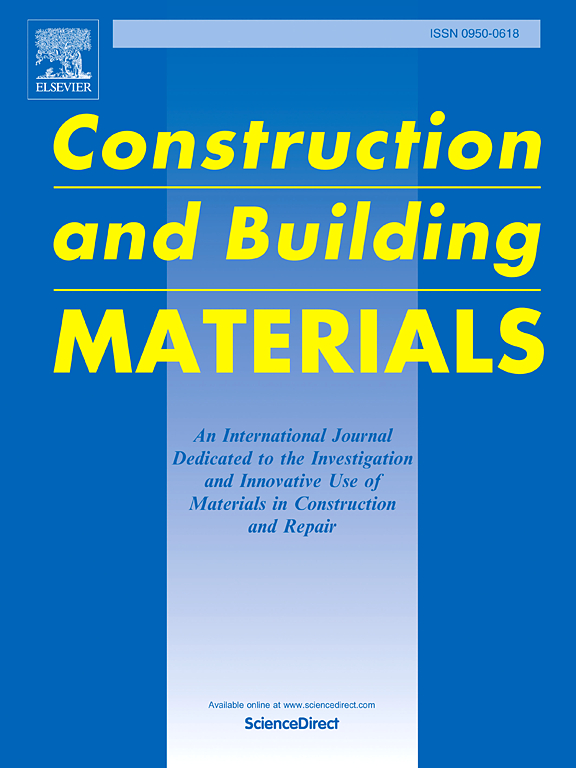Dynamic tensile properties of geopolymer aggregates engineered cementitious composites (GPA-ECC) with varying GPA replacement ratios
IF 7.4
1区 工程技术
Q1 CONSTRUCTION & BUILDING TECHNOLOGY
引用次数: 0
Abstract
To investigate the dynamic tensile properties of geopolymer aggregates engineered cementitious composites (GPA-ECC), this study conducted direct tensile tests at strain rates () of 10−5 s−1, 10−4 s−1, 10−3 s−1, and 10−2 s−1 on GPA-ECC with varying GPA replacement ratios (0 %, 25 %, 50 %, 75 %, and 100 %). Tensile properties, including tensile strength, tensile strain, strain energy density, and the strength index for pseudo-strain hardening (), were derived from the stress-strain curves. The dynamic increase factor (DIF) was introduced to characterise the relationship between dynamic tensile properties and strain rates. Fracture morphology, scanning electron microscopy (SEM), backscattered electron (BSE) imaging, and energy-dispersive spectroscopy (EDS) analyses were combined to examine crack behaviour and microstructural characteristics, elucidating the mechanisms by which strain rate and GPA influence the dynamic tensile properties of GPA-ECC. Macroscopic tensile results revealed that, under quasi-static conditions (10−5 s−1), the incorporation of GPA reduced tensile strength by up to 46.8 % but significantly enhanced ductility, energy absorption capacity, and strain-hardening ability, with maximum improvements of 125.2 %, 20.8 %, and 40.9 %, respectively. A comparison with other aggregate types of ECC reveals that the GPA-ECC with full replacement (F0G100) still maintains excellent strength levels. Under dynamic conditions with increasing strain rates (10−5 s−1 to 10−2 s−1), tensile strength increased, while tensile strain, strain energy density, and decreased. Additionally, GPA increased the strain rate sensitivity of the tensile properties, with more pronounced DIF variations observed at higher GPA replacement ratios. BSE-EDS analysis demonstrated that GPA interacted with the matrix, forming additional chemical bonds at the interfacial transition zone. SEM characterization of both fibre fracture morphology and fibre/matrix interfacial morphology revealed that the enhanced interfacial bonding was primarily responsible for the fracture failure of PE fibres under high-strain-rate loading.
不同GPA置换比的地质聚合物聚集体工程胶凝复合材料(GPA- ecc)的动态拉伸性能
为了研究地质聚合物聚集体工程胶凝复合材料(GPA- ecc)的动态拉伸性能,本研究在不同GPA替代率(0%、25%、50%、75%和100%)的GPA- ecc上进行了应变率(ε (ε))为10−5 s−1、10−4 s−1、10−3 s−1和10−2 s−1的直接拉伸试验。从应力-应变曲线中得到拉伸强度、拉伸应变、应变能密度和伪应变硬化强度指标(PSHstrength)。引入动态增加因子(DIF)来表征动态拉伸性能与应变速率之间的关系。结合断裂形貌、扫描电镜(SEM)、背散射电子(BSE)成像和能量色散光谱(EDS)分析,研究了裂纹行为和微观组织特征,阐明了应变速率和GPA影响GPA- ecc动态拉伸性能的机制。宏观拉伸结果表明,在准静态条件(10−5 s−1)下,GPA的掺入使材料的抗拉强度降低46.8%,但塑性、能量吸收能力和应变硬化能力显著提高,最大提高幅度分别为125.2%、20.8%和40.9%。与其他骨料类型的ECC进行比较,发现完全替换后的GPA-ECC (F0G100)仍保持优异的强度水平。在动态条件下,随着应变速率(10−5 s−1 ~ 10−2 s−1)的增加,抗拉强度增加,而拉伸应变、应变能密度和PSHstrength降低。此外,GPA增加了拉伸性能的应变速率敏感性,在较高的GPA替代率下观察到更明显的DIF变化。BSE-EDS分析表明,GPA与基体相互作用,在界面过渡区形成额外的化学键。纤维断裂形貌和纤维/基体界面形貌的SEM表征表明,界面结合增强是PE纤维在高应变率载荷下断裂失效的主要原因。
本文章由计算机程序翻译,如有差异,请以英文原文为准。
求助全文
约1分钟内获得全文
求助全文
来源期刊

Construction and Building Materials
工程技术-材料科学:综合
CiteScore
13.80
自引率
21.60%
发文量
3632
审稿时长
82 days
期刊介绍:
Construction and Building Materials offers an international platform for sharing innovative and original research and development in the realm of construction and building materials, along with their practical applications in new projects and repair practices. The journal publishes a diverse array of pioneering research and application papers, detailing laboratory investigations and, to a limited extent, numerical analyses or reports on full-scale projects. Multi-part papers are discouraged.
Additionally, Construction and Building Materials features comprehensive case studies and insightful review articles that contribute to new insights in the field. Our focus is on papers related to construction materials, excluding those on structural engineering, geotechnics, and unbound highway layers. Covered materials and technologies encompass cement, concrete reinforcement, bricks and mortars, additives, corrosion technology, ceramics, timber, steel, polymers, glass fibers, recycled materials, bamboo, rammed earth, non-conventional building materials, bituminous materials, and applications in railway materials.
 求助内容:
求助内容: 应助结果提醒方式:
应助结果提醒方式:


